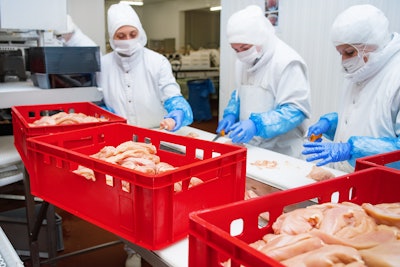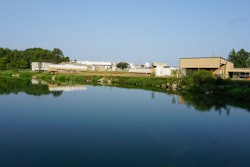
Over the past 10 years, industrial robots have made tremendous progress in multiple industries, including the back end of poultry plants. Additionally, the ability of robotics to replace repetitive and labor-intensive tasks, such as case-packing or palletizing, is well established in the industry. The challenge presented to the industry is, how do we utilize robots in an area that can be unpredictable and unstructured, like the front end of a plant?
On November 30, Gary V. McMurray, interim IRIM executive director & associate director, Collaborative Robotics and Division Chief, Principal Research Engineer, Food Processing Technology Division, Georgia Tech Research Institute, Mathias Konne, business development and marketing coordinator, North America, Staubli Corporation, and Jay Russell, key account manager, Marel Inc. presented why and how the future of the poultry industry is becoming more compatible with robotics.
Robots in an unstructured environment
Robots have been in poultry plants performing routine tasks like stacking boxes on pallets, but jobs that require more flexibility and need to be performed on items of varying shapes and sizes have been more difficult to automate. This is why the poultry industry cannot be compared to the automotive industry. Each bird or piece of meat coming down the line is not identical, McMurray explained.
This means for a robot to operate well in this environment, it needs to be accustomed to an unstructured environment. “We're not defining everything ahead of time,” stated McMurray. “The parts are coming in and random position and orientations, you can't control them. This means we need more complicated algorithms.”
To address this, the Georgia Tech Research Institute is developing an intelligent cutting system that captures an image of each bird coming down the line, predicts the location of the bones and tendons ahead of time and calculate a unique cutting trajectory for each bird.
“We're getting a customized path for every bird. This is really important when you want to be able to try to maximize yield, or value of the process,” stated McMurray.
Mcmurray went on to describe the idea of programming behaviors instead of codes into robots to allow for more flexibility and the ability to perform a wider range of tasks in different plant layouts. “We're not trying to redesign the robot itself. We're trying to have the software to build to make it more intelligent. And one of the things that we're trying to do is build simple behaviors. It makes it very easy for the user to be able to write new programs because we're thinking in terms of behaviors, and this is really what the human does.”
Robots and food safety
Because the food industry can have a wide range of environments (wet, cold, etc.), it’s important to think about the preparation required for a robot to safely and effectively to perform in a food environment.
According to Konne, there are five key factors a robot needs to be suited with the food industry, including a hygienic design to prevent bacterial harborage, compatibility with food grade oil, a pressurized structure to prevent microorganism growth, the ability to be 100% washable, and the capability to perform a range of different tasks.
“Robots have already arrived, and they do help workers.” stated Konne. “They offer a reduction in injuries. Most of the time robots are performing in environments that people don't want to be do not want to be working in or tasks that they don't want to be doing manually.”
Over the last few years, collaborative robotics (cobots) have become more established in the poultry industry, especially in case packing and palletizing areas. “The key thing about collaborative robots is they allow people and the robots to work in the same space,” explained Konne. “But with the collaborative robotics, they have sensors, so they can detect that contact with a person.”
Robotic picking and packing
To further incorporate robotics into poultry processing plants, Russel discussed the importance of packing different types of products into various types of packaging seamlessly and efficiently by utilizing different gripper interfaces. “From a range of boneless and bone-in products, we are able to fill a range of packaging from thermoforms to boxes to trays while styling the placement of these products,” explained Russel.
The concept uses a 3D vision technology and various robotic heads that work in conjunction to fill the packaging according to customer specifications. “This maintains a very high level of throughput and allows you to integrate up to three lanes of product while running up to two different tray sizes on either end of the machine,” explained Russel.
Additionally, robotic automation is offered in which the machines throughout deboning can all communicate with each other and request specific portion sizes to fill a fixed weight order, potentially helping reduce the occurrence of human error. “It's just an operator interface to change between different trays and different products,” he stated.
















